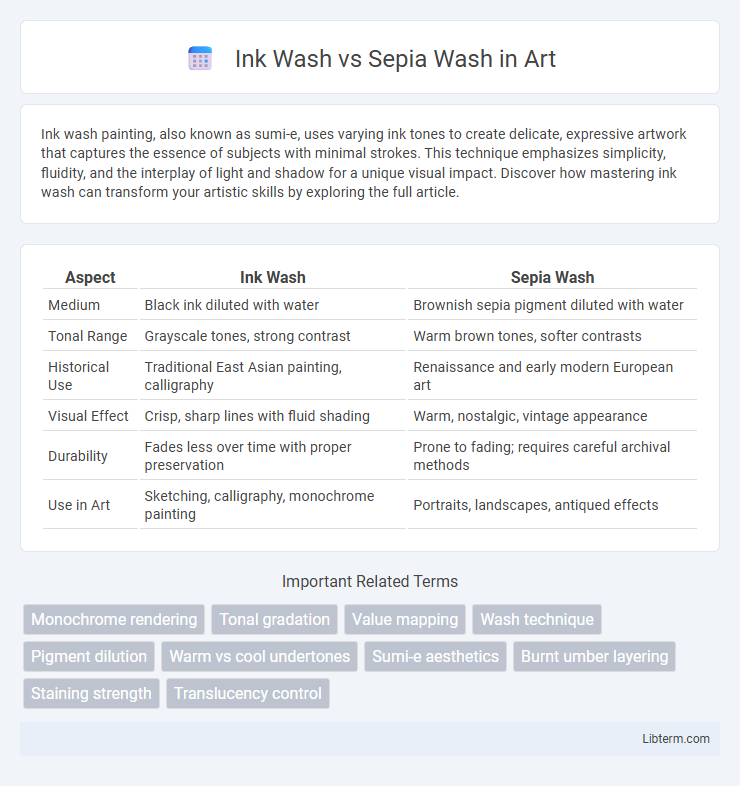Ink wash painting, also known as sumi-e, uses varying ink tones to create delicate, expressive artwork that captures the essence of subjects with minimal strokes. This technique emphasizes simplicity, fluidity, and the interplay of light and shadow for a unique visual impact. Discover how mastering ink wash can transform your artistic skills by exploring the full article.
Table of Comparison
| Aspect | Ink Wash | Sepia Wash |
|---|---|---|
| Medium | Black ink diluted with water | Brownish sepia pigment diluted with water |
| Tonal Range | Grayscale tones, strong contrast | Warm brown tones, softer contrasts |
| Historical Use | Traditional East Asian painting, calligraphy | Renaissance and early modern European art |
| Visual Effect | Crisp, sharp lines with fluid shading | Warm, nostalgic, vintage appearance |
| Durability | Fades less over time with proper preservation | Prone to fading; requires careful archival methods |
| Use in Art | Sketching, calligraphy, monochrome painting | Portraits, landscapes, antiqued effects |
Introduction to Wash Techniques
Ink wash and sepia wash are traditional painting techniques used to create tonal variations and depth by applying diluted pigments. Ink wash typically uses black or gray ink, enabling artists to achieve strong contrasts and intricate shading. Sepia wash employs brownish tones derived from sepia ink or pigment, offering warm, earthy hues that evoke a vintage or classical feel.
Understanding Ink Wash
Ink wash is a technique using diluted black ink to create varying tones and depth, emphasizing fluid brushwork and contrast. Sepia wash employs brown-toned ink derived from natural sources, producing warmer, vintage effects often seen in historical artworks. Understanding ink wash involves mastering control over dilution and brush pressure to achieve gradients and textures distinct from the richer, earthier hues of sepia wash.
Exploring Sepia Wash
Sepia wash, derived from the ink of the cuttlefish, offers a warm, brownish tone that enhances artwork with vintage and classical appeal, distinguishing it from the stark black contrast of traditional ink wash. Known for its translucent quality, sepia wash allows artists to build delicate layers and subtle tonal variations, ideal for rendering depth and texture in sketches and paintings. This medium is favored in fine art and restoration, providing a timeless aesthetic that contrasts with the modern, bold expression of ink wash techniques.
Historical Origins and Evolution
Ink wash originated in East Asia, particularly China, during the Tang Dynasty (618-907 AD), where it was developed as a technique for brush painting emphasizing fluidity and tonal variation. Sepia wash, derived from the ink of the common cuttlefish Sepia officinalis, gained popularity in Europe during the Renaissance as artists sought warm brown hues for sketches and washes. Both techniques evolved as artists refined methods to control dilution and brushwork, influencing diverse art movements and expanding expressive possibilities in monochromatic painting.
Materials and Tools Needed
Ink wash requires India ink or sumi ink, water for dilution, and brushes with soft bristles such as bamboo or sable for smooth gradients and tonal variations. Sepia wash uses sepia pigment, often derived from cuttlefish ink or synthetic sepia ink, combined with water, applied with fine watercolor brushes or pens to achieve warm brown tones and vintage effects. Both techniques benefit from high-quality watercolor paper or mixed media paper to handle layering and maintain texture.
Color Tone Differences
Ink wash features a monochromatic palette dominated by deep blacks and various shades of gray, creating stark contrast and dramatic shadows. Sepia wash employs warm brown tones that evoke a vintage or nostalgic feel, with softer transitions and a subdued, earthy color spectrum. The tonal difference significantly influences the mood: ink wash emphasizes sharpness and intensity, while sepia wash imparts warmth and antiquity.
Techniques in Application
Ink wash techniques involve using diluted black ink applied with brushes to create gradients and tonal variations, emphasizing fluidity and contrast. Sepia wash utilizes brownish sepia ink, offering warm tones that lend a vintage or classical feel, often layered to build depth and texture. Both techniques rely on controlled brush pressure and timing to manipulate opacity and achieve desired effects in watercolor or pen-and-ink artwork.
Effects and Textural Qualities
Ink wash produces deep, rich blacks with high contrast, offering bold definition and dramatic shading ideal for stark, graphic compositions. Sepia wash delivers warm, brownish tones that create a vintage, softer atmosphere, evoking a sense of nostalgia and subtle gradation. The textures in ink wash tend to be sharp and fluid with strong edge control, while sepia wash offers a more diffused, organic texture that enhances depth through gentle tonal variation.
Popular Uses in Art and Design
Ink wash is widely used in traditional East Asian brush painting and contemporary sketching for its dynamic range of tones and expressive brush strokes. Sepia wash, derived from natural sepia pigment, is popular in vintage-inspired illustrations, historical manuscript reproductions, and warm-toned watercolor effects. Artists and designers often choose ink wash for monochromatic depth and sepia wash to evoke nostalgia and timelessness in their work.
Choosing Between Ink and Sepia Wash
Choosing between ink wash and sepia wash depends on the desired tonal range and mood; ink wash offers deep, rich blacks ideal for strong contrasts, while sepia wash provides warm, brownish hues enhancing vintage or nostalgic effects. Ink wash is preferred for precise, detailed artwork requiring sharp lines and high contrast, whereas sepia wash suits softer, atmospheric pieces where subtlety and warmth are key. Artists should consider their palette, subject matter, and emotional tone to effectively select between the bold intensity of ink wash and the gentle warmth of sepia wash.
Ink Wash Infographic

 libterm.com
libterm.com